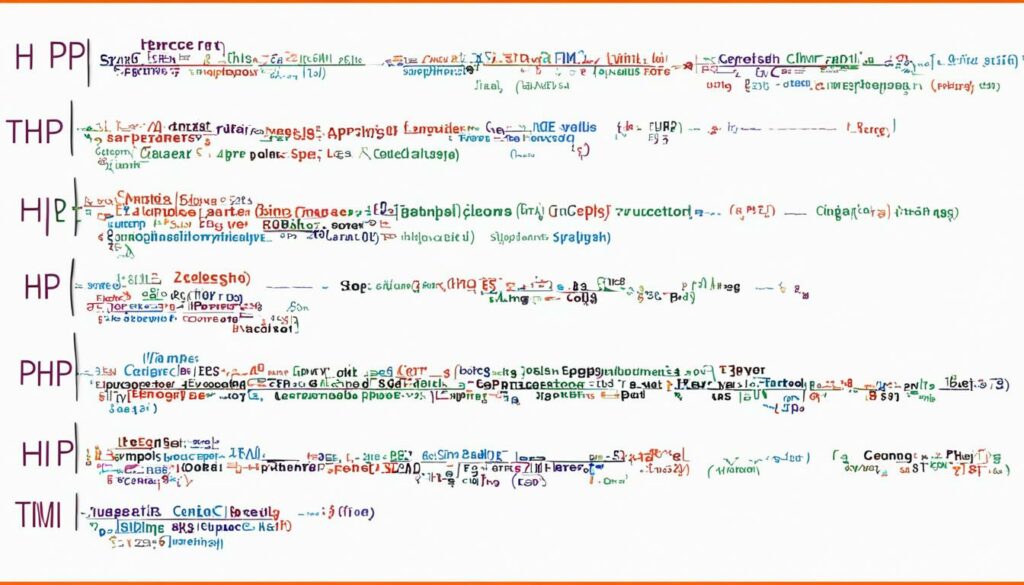Welcome to the world of PHP! Whether you’re just starting your journey in PHP programming or looking to enhance your skills, understanding this popular server-side scripting language is essential for web development. In this article, we’ll explore the fundamentals of PHP, its benefits, and its role in dynamic web applications.
Key Takeaways:
- PHP is a server-side scripting language used for web application development.
- It allows for server-side activity, such as interacting with databases and processing user requests.
- PHP is widely used in WordPress development for customization and monetization.
- Understanding PHP basics, syntax, and data manipulation is crucial for efficient programming.
- PHP offers strong integration with MySQL databases for efficient data retrieval and storage.
Basics of PHP & Server-Side Scripting
Welcome to the world of PHP! In this section, we will delve into the basics of PHP programming and server-side scripting. By gaining a solid understanding of PHP basics and syntax, you’ll be well-equipped to embark on your journey as a web developer.
PHP is a server-side scripting language that interprets scripts at runtime. This means that PHP code is executed on the server, allowing for dynamic generation of HTML code and interaction with databases. Unlike client-side scripting languages like JavaScript, PHP enables server-side activities in response to user requests.
In PHP, you can combine HTML and client-side scripts with your PHP code. This allows you to create dynamic web pages that respond to user input and display customized content.
Let’s take a look at the basic syntax of PHP. PHP code is enclosed in opening and closing PHP tags, like this:
The code between the PHP tags can include variables, functions, conditionals, loops, and other PHP constructs. The result of executing the PHP code will be embedded in the HTML output of the web page.
Here’s an example of PHP code that displays the current date:
As you can see, PHP uses a simplified syntax compared to other programming languages, making it easy to learn and use for web development.
Server-Side Scripting: A Powerful Tool for Web Development
Server-side scripting is a crucial aspect of web development, enabling interaction with databases, dynamic content generation, and server-side processing. With PHP’s server-side scripting capabilities, you can create robust and scalable web applications.
By learning PHP basics and mastering server-side scripting, you’ll have the power to build dynamic websites, handle user inputs, process data, and create personalized user experiences. PHP’s extensive functionality and compatibility with various databases make it an invaluable tool for modern web development.
Stay tuned as we explore further PHP concepts and dive into the exciting world of web development with PHP!
But first, here’s a visually appealing and relevant image to spark your imagination:
| PHP Basics | Server-Side Scripting | PHP Syntax |
|---|---|---|
| An introduction to PHP programming and its basics | Exploring the concept of server-side scripting in web development | The fundamental syntax and structure of PHP code |
| Setting up a PHP development environment | Understanding the advantages of server-side processing | Using PHP tags and writing PHP statements |
| Executing a simple PHP script | Interacting with databases using PHP | Working with variables and data types in PHP |
| Combining HTML and PHP code | Creating dynamic web pages with PHP | Conditional statements and loops in PHP |
| Understanding PHP error handling | Fetching and displaying data from a database | Common PHP functions and their usage |
What is PHP Good For?
PHP is a versatile and widely used scripting language that brings numerous benefits to web development. With its broad range of applications, PHP is the preferred choice for developers working on various projects. Let’s explore some of the key uses and benefits of PHP:
Cookies for Storing User Preferences
PHP enables developers to work with cookies, which are small text files stored on a user’s computer. Cookies help retain user preferences, such as language settings, layout preferences, or previous interactions with a website. By using PHP, you can create dynamic and personalized user experiences, resulting in enhanced engagement and satisfaction.
Performing Calculations and Mathematical Equations
PHP provides built-in functions and operators for performing calculations and mathematical operations. Whether you need to calculate totals, perform complex equations, or manipulate statistical data, PHP offers a reliable and efficient solution. Its powerful math capabilities make it an invaluable tool for web applications that require advanced calculations.
Data Collection and User Interactions
PHP simplifies the process of collecting and processing user data. It enables seamless interactions with web forms, allowing users to submit information or perform actions that trigger specific responses. By leveraging PHP, developers can create dynamic and interactive web pages that respond to user input, enhancing the overall user experience.
Creating Graphics with the GD Library
The GD library in PHP empowers developers to create and manipulate images. Whether you need to generate charts, thumbnails, or custom graphics, PHP offers a wide range of functions and methods to accomplish these tasks. The GD library’s capabilities combined with PHP’s flexibility enable developers to create visually appealing and dynamic content.
Server-Side Tasks and Data Management
PHP excels in server-side performance, making it the go-to language for tasks that require server interaction and data management. It is essential for developing dynamic websites, content management systems, and applications that rely on database interactions. PHP’s seamless integration with database management systems ensures smooth data retrieval, manipulation, and storage.
Community Support and Compatibility
One of PHP’s greatest strengths is its vast and supportive community. Whether you need guidance, troubleshooting assistance, or access to resources, the PHP community is always ready to help. Additionally, PHP is highly compatible with various operating systems and database management systems, providing developers with flexibility and ease of implementation.
Take a look at the following table to get a clearer overview of PHP’s uses and benefits:
| Use | Benefit |
|---|---|
| Working with cookies | Personalized user experiences |
| Performing calculations | Efficient data processing |
| Data collection and user interactions | Interactive web experiences |
| Creating graphics with the GD library | Visually appealing content |
| Server-side tasks and data management | Efficient and scalable applications |
| Community support and compatibility | Continuous learning and flexibility |
As you can see, PHP offers a wide range of applications and benefits in the field of web development. From personalized user experiences to efficient data management, PHP empowers developers to create robust and dynamic web solutions. Its versatility, community support, and compatibility make it an indispensable tool for aspiring and experienced web developers.
https://www.youtube.com/watch?v=-QiIVGrXgig
Difference Between HTML and PHP
When it comes to web development, HTML and PHP are two important languages that serve different purposes. HTML (Hypertext Markup Language) is primarily responsible for the structure and content of web pages. It defines the layout, headings, paragraphs, links, images, and other elements that make up the visual presentation of a website. HTML is considered a client-side language because it runs on the user’s web browser, rendering the web page based on the code provided.
On the other hand, PHP (Hypertext Preprocessor) is a server-side scripting language. It is used for performing server-side tasks and generating dynamic content. PHP scripts are executed on the server before the HTML is sent to the user’s browser. This allows PHP to interact with databases, perform calculations and data manipulations, handle form submissions, and more.
Client-Side vs Server-Side
One of the key differences between HTML and PHP is their execution location. HTML is client-side, meaning it runs on the user’s browser and is responsible for rendering the web page. PHP, on the other hand, is server-side, executing on the server and generating the HTML code to be sent to the user’s browser.
HTML focuses on the presentation layer, controlling how the content is displayed and structured. It uses tags and attributes to define and style elements on the page. PHP, however, is concerned with the functionality of the website. It can interact with databases, handle user input, and perform complex calculations.
Web Development Languages
HTML and PHP are both essential web development languages, but they serve different purposes. HTML is the backbone of a website, providing the foundation for its structure and content. It allows developers to create visually appealing and interactive web pages.
PHP, on the other hand, enhances the functionality of a website. It enables data processing, database interactions, and dynamic content generation. With PHP, developers can create web applications that respond to user input and deliver personalized experiences.
By combining HTML and PHP, developers can create powerful and dynamic websites that provide both an attractive design and efficient functionality. HTML handles the visual aspects, while PHP takes care of the behind-the-scenes tasks, making them a perfect combination for modern web development.
Understanding the difference between HTML and PHP is fundamental in web development. HTML focuses on the presentation layer, while PHP enables server-side actions and dynamic content generation. Mastering both languages allows developers to create rich and interactive websites that provide a seamless user experience.

We recommend WordPress Hosting from BoostedHost for optimal performance. Sign up now through this link: www.boostedhost.com/wordpress-hosting.
PHP and MySQL Databases
Integrating PHP with MySQL databases opens up a world of possibilities for efficient data retrieval, manipulation, and storage. PHP effortlessly supports various database management systems, including MySQL, PostgreSQL, and SQLite. With its seamless integration, PHP empowers developers to interact with databases through SQL queries, perform essential CRUD operations (Create, Read, Update, Delete), and create database-enabled web pages and applications.
PHP and MySQL database integration is crucial for a multitude of tasks, from managing inventories and setting up search features to creating automated picture galleries. By leveraging the power of PHP, developers can seamlessly connect their web applications to the MySQL database, allowing for smooth data management and manipulation.
Benefits of PHP and MySQL Integration
When combining PHP and MySQL, developers can take advantage of the following benefits:
- Efficient Data Retrieval: PHP enables the retrieval of specific data from MySQL databases, ensuring quick and seamless access to relevant information.
- Data Manipulation: With PHP, developers can effortlessly manipulate and transform data stored in MySQL databases, facilitating the creation of dynamic and personalized content.
- Secure Data Storage: PHP’s integration with MySQL ensures secure data storage, offering features like user authentication and password encryption to safeguard sensitive information.
- Scalability: PHP and MySQL provide excellent scalability, allowing developers to handle large volumes of data and accommodate future growth without sacrificing performance.
By harnessing the power of PHP and MySQL integration, developers can create robust web applications that offer seamless data management, enhanced user experiences, and efficient data processing capabilities.

| PHP Function | Description |
|---|---|
| mysqli_connect() | Establishes a new connection to the MySQL server |
| mysqli_query() | Executes a query on the database |
| mysqli_fetch_array() | Fetches a result row as an associative, numeric, or both array |
| mysqli_insert_id() | Returns the auto-generated ID used in the last query |
| mysqli_close() | Closes the database connection |
PHP for WordPress
PHP plays a vital role in WordPress development. It powers customized WordPress plugins and themes, allowing developers to create unique features and functionalities for WordPress websites. With PHP’s flexibility, you can customize default actions, integrate external APIs, and build interactive elements to enhance user experience. By leveraging PHP in WordPress, you can create personalized websites that stand out from the crowd.
WordPress customization is made possible through PHP’s ability to communicate directly with the WordPress server. Developers can make specific requests for actions like retrieving data from the website’s database, updating content, or handling user interactions. This direct communication enables dynamic content generation, ensuring that websites built with WordPress and PHP are interactive and responsive.
When it comes to creating personalized themes and plugins, PHP is essential. Understanding PHP enables you to modify existing themes and plugins or create your own from scratch. With PHP, you can seamlessly integrate custom functionalities, such as social media integrations, e-commerce features, or advanced content management systems. It allows you to tailor your WordPress site to meet specific requirements and deliver a unique experience for your audience.
“PHP empowers you to shape your WordPress website according to your vision. Its customization capabilities allow you to build a site that reflects your brand and engages your audience.”
Learning PHP opens up opportunities for monetization through WordPress customization and development. As a PHP developer, you can offer your services to clients seeking tailored WordPress solutions, creating additional income streams. You can also develop and sell your own themes and plugins, tapping into the vast WordPress market and generating passive income.
BoostedHost: The Ideal WordPress Hosting Solution
If you’re looking for optimal performance and reliability for your PHP-powered WordPress website, we recommend WordPress Hosting from BoostedHost. Their hosting packages are specifically optimized for WordPress sites, ensuring seamless integration and superior performance. With their advanced features, including automatic updates, robust security measures, and excellent customer support, BoostedHost offers a hosting solution that takes your WordPress site to the next level.
Sign up now through this link: www.boostedhost.com/wordpress-hosting and experience the power of PHP and WordPress in perfect harmony.

| Benefits of PHP in WordPress | Examples |
|---|---|
| Customization | Modify default behaviors of WordPress themes and plugins. |
| Advanced Functionality | Create custom features like payment gateways, contact forms, and dynamic content. |
| Integration | Integrate external APIs, social media platforms, and third-party services. |
| Monetization | Develop and sell personalized themes and plugins, or offer customization services to clients. |
PHP File Extension and Syntax
When working with PHP, it is important to understand the file extension and syntax used in PHP code. PHP files have the .php extension, indicating that they contain PHP code. This file extension helps the server identify and process the PHP code within the file.
The syntax of PHP is relatively simple, making it easy to learn and use. PHP code is enclosed within PHP tags, which are typically written as “<?php” and “?>”. The PHP code is placed between these opening and closing tags, allowing the server to recognize and execute the PHP instructions.
It’s worth noting that PHP allows for the inclusion of HTML code or client-side scripts like JavaScript within the same file. This flexibility enables seamless integration of PHP with other web development languages, making it a powerful tool for creating dynamic and interactive websites.
Here’s an example to illustrate the PHP syntax:
<?php
$name = “John”;
echo “Hello, ” . $name . “!”;
?>
In the example above, the PHP code assigns the value “John” to the variable “$name” and then uses the “echo” statement to display the message “Hello, John!” on the webpage.
Learning the PHP file extension and syntax is crucial for effectively working with PHP files and writing correct code. It forms the foundation for integrating PHP with other web development languages, enabling the creation of dynamic and feature-rich websites.
PHP File Extension and Syntax
| File Extension | Syntax Example |
|---|---|
| .php | <?php $variable = “Value”; echo $variable; ?> |

PHP Data Types and Operators
When working with PHP, it is crucial to understand the different data types available and how to effectively manipulate them. PHP supports a variety of data types, including:
- Integers: Whole numbers without decimal points.
- Strings: Sequences of characters.
- Floats: Numbers with decimal points.
- Arrays: Collections of values.
- Booleans: True or false values.
By utilizing these data types, you can store and manage data in a structured and efficient manner. For example, you can use integers to represent quantities, strings to store textual information, or arrays to hold multiple values.
Alongside data types, PHP provides a wide range of operators that allow you to perform operations on variables. These operators include:
- Arithmetic Operators: Perform mathematical calculations such as addition (+), subtraction (-), multiplication (*), division (/), and modulus (%).
- Comparison Operators: Compare the equality or inequality of values using operators like equal to (==), not equal to (!=), greater than (>), and less than (
- Logical Operators: Combine multiple conditions using operators like AND (&&), OR (||), and NOT (!).
- Assignment Operators: Assign values to variables using operators like equals (=), plus equals (+=), and minus equals (-=).
By mastering PHP data types and operators, you can write efficient and accurate code that performs the desired operations and manipulates data effectively.
Example:
Here’s an example that showcases the usage of PHP data types and operators:
$price = 10;
$discount = 2.5;
$taxRate = 0.08;
$total = ($price – $discount) * (1 + $taxRate);
echo “Total price: $” . $total;
In this example, we have defined variables for the price, discount, and tax rate. We then calculate the total price by subtracting the discount from the price, applying the tax rate, and assigning the result to the variable $total. Finally, we display the total price using the echo statement.
| Data Type | Examples |
|---|---|
| Integer | 0, 42, -10 |
| String | “Hello, World!”, ‘PHP is awesome!’ |
| Float | 3.14, -0.5, 2.0 |
| Array | [1, 2, 3], [‘apple’, ‘banana’, ‘orange’] |
| Boolean | true, false |
PHP Cookies and Sessions
In PHP, cookies and sessions play crucial roles in managing user interactions, identifying users, and storing user preferences. By leveraging PHP’s capabilities, you can create personalized user experiences and ensure efficient user management.
PHP Cookies
PHP enables the handling of cookies, which are small files stored on users’ computers. These cookies allow you to identify users and store data for future use. With PHP, you can create, modify, and retrieve cookies, providing a seamless browsing experience to your users by remembering their preferences.
“By utilizing PHP cookies, you can customize your website based on user preferences, such as remembering language settings or displaying personalized content.”
For example, suppose you want to remember a user’s preferred language. You can create a cookie using PHP that stores this information. The next time the user visits your website, PHP can retrieve the cookie, identify the preferred language, and display the website content accordingly.
PHP Sessions
PHP sessions enable the storage of user data and the maintenance of state throughout a browsing session. Unlike cookies, which are stored on users’ computers, sessions store data on the server. This allows for secure and efficient management of user interactions.
“With PHP sessions, you can store important user data securely on the server, ensuring a smooth browsing experience even when users navigate across multiple pages.”
For instance, when a user logs into a website, PHP can start a session and store relevant user information, such as username or user ID. This information can then be accessed on different pages of the website, eliminating the need to repeatedly authenticate the user or ask for the same information during their session.
PHP Cookies vs. Sessions
| Feature | PHP Cookies | PHP Sessions |
|---|---|---|
| Data Storage | Stored on users’ computers | Stored on the server |
| Data Size | Limited to a few kilobytes | Scalable, limited by server resources |
| Data Security | Less secure, as cookies can be tampered with | More secure, as data is stored on the server |
| Lifespan | Can be set with an expiration date | Available until the session ends or is terminated |
| Usage | Remembering user preferences, tracking user activity | Storing user data, managing user sessions |
In summary, PHP’s cookie and session management capabilities are essential for creating personalized user experiences, ensuring efficient user management, and enhancing the overall functionality of your web applications. By understanding how to utilize PHP cookies and sessions effectively, you can deliver a seamless browsing experience to your users.
We recommend WordPress Hosting from BoostedHost for optimal performance. Sign up now through this link: www.boostedhost.com/wordpress-hosting.
Conclusion
In conclusion, PHP is a powerful server-side scripting language that plays a significant role in web development. Its versatility, database integration, scalability, and extensive community support make it an invaluable tool for building dynamic websites and applications. With PHP, you can handle cookies, manipulate data, interact with databases, and create engaging content.
One of the notable strengths of PHP is its compatibility with WordPress customization. By leveraging PHP, you can customize WordPress themes and plugins, bringing unique features and functionalities to your websites. This opens up opportunities for monetization and allows you to create personalized user experiences.
Furthermore, PHP’s compatibility with various databases enhances its significance in the web development landscape. Whether you’re using MySQL, PostgreSQL, or SQLite, PHP provides seamless integration, enabling efficient data retrieval, manipulation, and storage.
To take advantage of PHP’s features and capabilities, it’s essential to learn the language. By mastering PHP, you can create robust and customized solutions, expanding your opportunities in the web development field. So, don’t miss out on the advantages that PHP brings to the table!
FAQ
Q: What is PHP?
A: PHP is a server-side scripting language used for the development of web applications, dynamic websites, and static websites. Originally known as “Personal Home Pages,” PHP has evolved into “Hypertext Preprocessor.”
Q: What are the basics of PHP and server-side scripting?
A: PHP is a server-side scripting language that interprets scripts at runtime. It allows for server-side activity by receiving requests from web browsers and executing instructions to generate HTML code. PHP files can include HTML and client-side scripts like JavaScript.
Q: What is PHP good for?
A: PHP has a range of uses and benefits in web development. It is commonly used for working with cookies, performing calculations, collecting user details, and creating graphics. PHP is preferred for server-side tasks and data management, making it essential for applications that require database interactions.
Q: What is the difference between HTML and PHP?
A: HTML is a markup language responsible for the structure and content of web pages, while PHP is a scripting language used for server-side tasks and dynamic content generation. HTML is mainly used for altering the appearance and format of web pages, while PHP allows for interactions with databases and server-side actions.
Q: How does PHP work with MySQL databases?
A: PHP has strong integration with MySQL databases, allowing for efficient data retrieval, manipulation, and storage. PHP supports various database management systems, including MySQL, PostgreSQL, and SQLite. It enables developers to interact with databases through SQL queries and perform CRUD operations.
Q: What is PHP’s role in WordPress development?
A: PHP plays a vital role in WordPress development by powering customized plugins and themes. It allows for direct communication with the WordPress server, making requests for specific actions and content. Understanding PHP is essential for customizing default actions and creating personalized themes and plugins.
Q: What is the PHP file extension and syntax?
A: PHP files have the .php extension and contain PHP code within them. The syntax of PHP involves using PHP tags to enclose the code. PHP can also include HTML or client-side scripts like JavaScript within the same file.
Q: What are the PHP data types and operators?
A: PHP supports various data types, including integers, strings, floats, arrays, and booleans. It also provides a wide range of operators for performing operations on variables, including arithmetic, comparison, logical, and assignment operators.
Q: How does PHP handle cookies and sessions?
A: PHP enables the handling of cookies for user identification and storing preferences. It also provides sessions for managing user interactions during a browsing session. Understanding PHP cookies and sessions is important for creating personalized user experiences and efficient user management.
Q: What makes PHP a powerful tool for web development?
A: PHP is a powerful server-side scripting language widely used in web development for its versatility, database integration, scalability, and extensive community support. Its ability to handle cookies, manipulate data, interact with databases, and create dynamic content makes it a valuable tool for building websites and applications.












